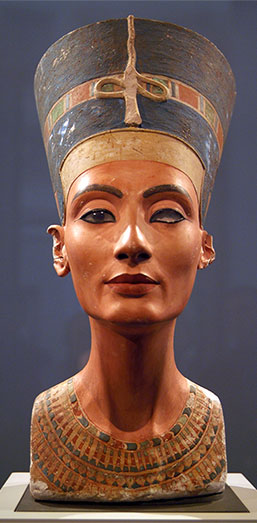To come straight to the point, the ultimate truth does not exist. So far. Because much could change if the assumptions should confirm that behind a wall in the grave chamber of the tomb KV62 in the Valley of the Kings, the tomb of Tutankhamen, another chamber could be located – a chamber that could be associated with Nefertiti. This would be the most sensational archaeological find of the century and the solution to one of the oldest puzzles in Egyptology.
Every year millions of visitors come to see the world-famous bust of Nefertiti, whose name Neferet-iti means “The beautiful one who comes along”, on the Museum Island in Berlin. Nefertiti was the wife of Akhenaten beautiful (“The one who is complacent to the Aten”), the famous ruler of the 18th dynasty in Egypt. She herself possessed considerable power and political influence, as attested by numerous other representations of her.
In the couple’s turning towards the cult of Aten during the 4th year of the reign of Akhenaten, in which he casts off his old name Amenhotep (IV.), and in order to underline their religious orientation, Nefertiti assumed the epithet Nefer-neferu-Aten, “Beautiful are the beauties of Aten”. The family relocated the court from Thebes to the new capital Akhetaten (“The Horizon of Aten”, today Tell el-Amarna) in Middle Egypt, which was specially laid out and built for the Aten cult.
Together Nefertiti and Akhenaten had six daughters, of common sons of the two, however, nothing is known.
It was not only the new faith that made the royal family exceptional. They were also the first royal couple in Egyptian history that made their private life public. This is attested by numerous depictions of family scenes in art and architecture. Sacred protection of the family was always granted by the solar disk of Aten with its characteristic rays, the ends of which shaped as hands.
The self-created world of the monotheistic belief in Aten existed only for a few years. The traditional religious orientations were deeply rooted in the Egyptian people, and the radiance of the new faith did now have enough power to reach out across the city walls of Amarna. After the death of Akhenaten the court and religious life returned to Thebes and Amarna was left to decay.
The end of the royal family is shrouded in myth. Akhenaten’s and Nefertiti’s joint reign must have extended over at least 16 years, this is attested by a recently discovered inscription in a quarry near Akhetaten, in which both Nefertiti and Akhenaten are mentioned in the 16th year of his reign (“year 16, 3rd month, Day 15”). What happened afterwards is still unclear.
Maybe Nefertiti had survived her husband – this could testified by depictions of her as a goddess on the stone sarcophagus of her husband – and ruled Egypt after him for a short time. It is believed that as a ruler she assumed the male name of named Smenkhkare. Her daughter Meritaton is mentioned in sources as her co-regent.
The cause of her death as well as the time and place are unknown. Until today fragments of a shabti, found in the royal necropolis of Akhetaten, have been regarded as proof that Nefertiti found their final resting place here until.
This hypothesis may perhaps be rewritten in the light of new research – we may be curious.
RELATED LINKS:
http://www.bbc.com/news/world-middle-east-34410720
http://m.spiegel.de/wissenschaft/mensch/a-1062030.html

